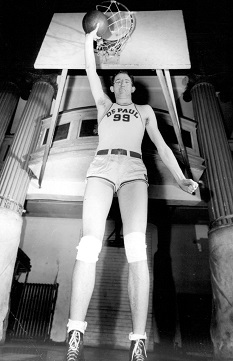
Word of the Day: Laudable
Paul Schleifer
Laudable, pronounced /ˈlɔ də bəl/ (or [law-duh-buh l] for those who do not know the International Phonetic Alphabet, or IPA), means praiseworthy. According to www.etymonline.com, the word comes into our language in the 1500s, “from Old French laudable ‘praiseworthy, glorious’ and directly from Latin laudabilis ‘praiseworthy,’ from laudare ‘to praise, commend, extol.’” Further, under laud, we find “Probably from an echoic PIE root *leu- and cognate with Old English leoð ‘song, poem, hymn,’ from Proto-Germanic *leuthan (source also of Old Norse ljoð ‘strophe,’ German Lied ‘song,’ Gothic liuþon ‘to praise’).”
So if someone is laudable, we should sing their praises.
If you are a basketball fan, this is your time of year. The Philadelphia 76ers just earned a spot in the NBA playoffs for the first time in half a decade. The Final Four of the NCAA tournament has been decided. The final four of the NIT, the National Invitation Tournament, has also been set, though most people really don’t care.
But on this date in 1945, when the NIT was the most prestigious college basketball tournament in the country (for a variety of reasons that I won’t go into), the De Paul University Blue Demons defeated Bowling Green 71-54 behind a 34-point performance by George Mikan, the first big man of basketball.
Born in 1924, Mikan was anything but an athlete growing up. He spent a year and a half in bed as a teen after breaking his knee. He was awkward and near-sighted, wearing thick glasses. But De Paul coach Ray Meyer noticed him on campus during Mikan’s freshman year, and decided to try to make a basketball player out of him. Why? Young George Mikan was 6’10” and 245 pounds. So Meyer got him to hit the weights and taught him to shoot a hook shot, with both hands. The drill he used on Mikan came to be called the Mikan Drill.
Now, this was at a time when tall guys were deemed unfit for the game of basketball because they were less coordinated than the shorter guys. Things have changed since the 1940s. Today 6’10” Ben Simmonds plays point guard for the Philadelphia 76ers. Just for comparison, the two forwards chosen to be All-Americans in 1945 were 6’1” and 6’2”. There were other tall players: Bob Kurland was also an All-American in 1945, with Mikan, and he was 7’ tall, but he never played beyond college.
Mikan was one of those players who actually changed the game of basketball. For instance, the three years during which he played for De Paul (and before), there was no rule against goal tending. Mikan once described De Paul’s defense: “We would set up a zone defense that had four men around the key and I guarded the basket. When the other team took a shot, I’d just go up and tap it out.” The NCAA then outlawed goal tending, followed later on by the NBA.
After De Paul, Mikan joined the Chicago American Gears of the National Basketball League. In his rookie season in the NBL, he was named MVP of the NBL tournament. Mikan moved to the Minnesota Lakers (yes, they were in Minnesota, the land of 10,000 lakes, first) where he was chosen league MVP, leading the Lakers to the NBL championship. The next year, the Lakers and three other teams jumped to the Basketball Association of America (the BAA), where again Mikan led the Lakers to the championship. For the ’49-’50 season, the NBL and the BAA merged to form the NBA. Over the next 6 seasons, the Lakers won the championship four times. The only NBA to have a more successful run was the Boston Celtics during the Bill Russell era.
Another rule that Mikan helped to bring in was the shot clock. In the 1950-51 season, the Lakers were playing the Fort Wayne Pistons. The Pistons took a 19-18 lead and got the ball. Then, for the rest of the game, they passed the ball around with no effort to score, afraid that if they did try, the Lakers would get the ball back, and Mikan would lead them back. A similar kind of thing happened in the NCAA years later, and the NCAA imposed a shot clock as well. Another rule change in the NBA, the Mikan Rule, widened the lane from 6’ to 12’ across—if you want to know why the place above the free-throw line is called the top of the key, look at photographs of the pre-Mikan Rule lane.
Mikan retired after the 1956 season, in large part due to the many injuries he had to endure during his playing days. But some years later he was invited to be the commissioner of the newly established American Basketball Association (ABA) in 1967. To entice fans to watch the new league, Mikan introduced the red-white-and-blue ball and the 3-point line. After the ABA was absorbed by the NBA, the ball was kept on as the “money ball” in the NBA three-point shooting contest, and the 3-point line has become a part of both the college and pro game.
George Mikan passed away in 2005. He is not as well remembered as Bill Russell, Wilt Chamberlain, Kareem Abdul Jabar, and Michael Jordan. He probably was not as good as they were. But he may very well have had a much greater influence on the game than any other player in the history of the sport.
He deserves our songs of praise; he is truly laudable.
The image is of George Mikan in 1945, the year De Paul won the NIT. It comes from the archives of The Sporting News.